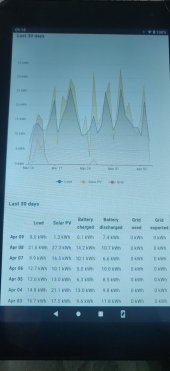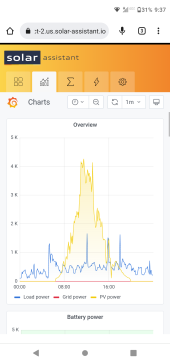I want to have a back up battery system (just for critical loads) but am confused as to how they are to be used. If I need to invest 10-15K into a backup battery system are the batteries just to sit there in the event of a grid failure? I was hoping to draw from the batteries on a regular basis, operating whatever load they can to reduce my dependency and bill from the power company. Is this not a recommended use?
Cycling batteries or not depends on a few things, including inverter/charger capabilities.
Whether you want to cycle or not depends on cost & cycle life of batteries, and utility tariff (time of use? 100% credit for backfeed under net metering or not?)
Some inverters can blend power from battery, and/or power from PV, with grid. Others are strictly a UPS, either grid or battery supplies loads, and PV can charge battery.
Cycling a battery wears it out. Some could wear out in a fraction of their shelf (or float) life if cycled once per day, others would still have similar life. Cycled multiple times per day would shorten life.
I've seen batteries costing as little as $0.05/kWh of cycle life (server rack or DIY LiFePO4 cells), < $0.05/kWh (salvaged cells), or as high as $0.50/kWh (AGM, name brand lithium like LG-RESU)
I've seen utility rates from $0.05 to $0.50 and higher per kWh.
If cycling a battery costs more than buying from grid, better to just keep battery floated for backup purpose. That's what I do with AGM.
If battery + PV and everything else costs less than grid, then storing and using power can make sense.
If inverter can't blend power with grid, then you need one that can operate off-grid and carry your largest load, including starting motors. This can be very expensive.
If it can blend, then you can size equipment according to how much of your own power you want to make.
There are AC coupled batteries like Tesla PowerWall and others which can offset grid consumption.
If your tariff credits you something like $0.025/kWh and charges $0.50/kWh, then storing to a battery in order to avoid export, and drawing from battery to avoid import (especially at times of day with highest rates) could make sense. California's NEM 3.0 is intended to force you to do this.
DIY grid-tie PV can cost $0.03/kWh (amortized over 20 years), and turn-key installed systems can cost $0.10/kWh. These do blend with grid power. I have a large system like this, plus a small battery backup. When grid is down, PV capacity greater than loads like A/C mostly keep battery floating during the day, so battery only cycles at night.
Batteries are expensive, wear out, represent some degree of safety hazard. I believe in avoiding or minimizing battery unless you need to operate off-grid. A small backup system for telecom could be useful.




